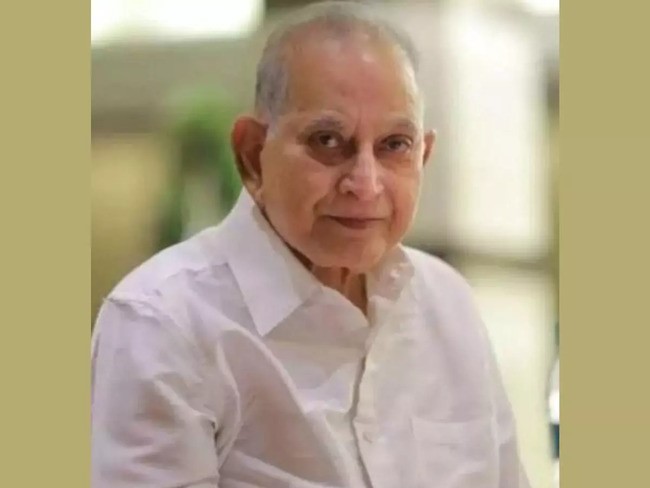
Krishna obit: Andhra's James Bond who turned Telugu cinema's heartthrob

By the time Ghattamaneni Sivarama Krishana Murty, popularly known as Krishna made his debut in Telugu cinema, the industry was under the spell of two towering actors, Akkineni Nageswara Rao (ANR) and NT Ramarao (NTR) with their legion of fans.
The two leading actors – NTR and ANR – had successfully replaced the hero of yesteryear, Chitoori V Nagaiah and were dominating Telugu films spinning out social dramas, mythology and folklore films. Their reign had heralded a new culture, the fans associations, which was until then not common in Andhra Pradesh.
A tragic incident in Vijayawada showed the extent of the popularity these legendary actors enjoyed in the state. On the 100th-day celebration of ANR’s Balaraju in July 1948, thousands of fans turned up at the theatre and the police had to resort to lathi charge to control the mob. Many were injured in the lathi charge but this kind of crowds in theatres before the screening of their movies became the norm.
“This was the beginning of the era of fan clubs in Andhra Pradesh,” said noted film studies expert SV Srinivas. While ANR’s stardom was defined by the roles he played as a romantic star in films such as Laila Majnu (1949), Devasadu (1953), Missamma (1955), Mayabazar (1957), Gundamma Katha (1962); NTR endeared himself to masses through his stellar performances in folk-based films and mythologies as Rama and Krishna.
The famed ANR and NTR were ruling the roost in Andhra with fan clubs spread across the state, when Krishna started his acting career.
The experimental hero
Krishna knew he had to offer something new to the Telugu audiences or else it would be difficult for any newcomer to gain a foothold in the industry. Even though he co-starred with the two leading heroes in many films, there was tension. By and large, this undeclared rivalry went on to shape the content of his movies, which luckily were successful and became milestones of this flamboyant actor’s career spanning over five decades.
Also read: Telugu star Mahesh Babu’s actor father GS Krishna dead
Krishna, often referred to as Superstar Krishna, (the father of actor Mahesh Babu) had more successful films than flops.
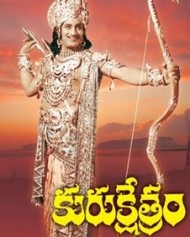 Krishna’s movies, with their innovative themes, helped him to make a mark in Telugu films. To prove that he was good as ANR and NTR, he did not hesitate to remake Devadasu, ANR’s masterpiece and made Kurukshetram, a movie based on the Mahabharata war. It’s an open secret that he earned NTR’s wrath for venturing into what he saw as his realm.
Krishna’s movies, with their innovative themes, helped him to make a mark in Telugu films. To prove that he was good as ANR and NTR, he did not hesitate to remake Devadasu, ANR’s masterpiece and made Kurukshetram, a movie based on the Mahabharata war. It’s an open secret that he earned NTR’s wrath for venturing into what he saw as his realm.
Krishna’s debut film Thenemanashulu (1965), which was directed by Adurti Subbarao was a modest success. A scene in this movie where Krishna, while chasing a car on a two-wheeler, jumps on to a speeding car was shot without a double.
Impressed by the budding actor’s feat, producers Doondi (Doondeswara Rao Pothina) and Sunderlal Nehata wanted to do an experimental film with Krishna. It was the time when detective novels were extremely popular. They thought they had found the right person to introduce a new genre – spy thrillers- to cater to the Telugu youth and neo-literates whose staple was pocket-sized detective novels and weekly magazine serials.
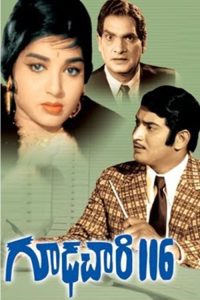 Krishna also jumped at the idea of seeing an opportunity here for him. The result was arguably India’s first spy movie Gudachari 116 (Detective 116). G-116, with actress Jayalalithaa, appeared as many as 14 years before the much-acclaimed Hindi flick, Mithun Chakravarthy’s Surakksha (1979).
Krishna also jumped at the idea of seeing an opportunity here for him. The result was arguably India’s first spy movie Gudachari 116 (Detective 116). G-116, with actress Jayalalithaa, appeared as many as 14 years before the much-acclaimed Hindi flick, Mithun Chakravarthy’s Surakksha (1979).
Krishna’s G-116’s rival at the box office was none other than NTR’s Sri Krishanatulabaram, a Mahabharat movie released in August 1966. Still, G-166 emerged as a box-office grosser. Had Krishna stuck to doing traditional social dramas, it would have taken him ages to become Tollywood’s superstar. His gamble had paid off.
Also read: SS Rajamouli’s next film with Mahesh Babu, a ‘globetrotting adventure, Indiana Jones’ style!
G-116, which appeared at the height of tensions between India and Pakistan, had many elements of patriotism and showed India’s thrust to become a space power. The plot revolved around how a few traitors attempt to kidnap scientists involved in the development of a satellite to be able to steal their technology. Gudachari 116 foiled the plans of the evil kidnappers and saved the day.
Andhra’s James Bond
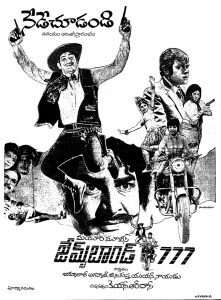 Overnight, the movie transformed Krishna into ‘Andhra’s James Bond’. This success was followed by six James Bond like movies such as James Bond 777 (1971), Agent Gopi (1978), Rahasya Gudachari (1981), Gudachari 117(1989) and all were sensational hits at the box office. These movies, coupled with other subjects, made him popular and catapulted him to the status of a ‘superstar’.
Overnight, the movie transformed Krishna into ‘Andhra’s James Bond’. This success was followed by six James Bond like movies such as James Bond 777 (1971), Agent Gopi (1978), Rahasya Gudachari (1981), Gudachari 117(1989) and all were sensational hits at the box office. These movies, coupled with other subjects, made him popular and catapulted him to the status of a ‘superstar’.
Another genre that Krishna successfully brought to Telugu audiences was cowboy movies. In these films, he proved his mettle as an inimitable actor.
Krishna, the producer
In 1971, Krishna launched his production house called Padmalaya Studios. Its first production Sakshi was a disappointment. He was in search of a theme that would put the banner in the big league. It was the time when Western cowboy movies such as For A Few Dollars More (1965), The Good, The Bad and The Ugly (1966) and Mackenna’s Gold( 1969) became insanely popular with Indian audiences.
Krishna felt he could tap into this genre, though it was foreign and alien in India. But, he felt it might be successful like his earlier spy movies. He took the help of noted lyricist and litterateur Arudra to pen a cowboy story set against the Indian context.
A fictional tale, set in 18th century Bobbili area of colonial Andhra, where anarchy was unleashed by the rivalry between British and French forces, was rustled up.
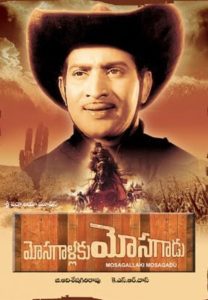 Also read: Political overtones in Mahesh Babu’s ‘Sarkaru Vari Paata’ trigger troll war in AP
Also read: Political overtones in Mahesh Babu’s ‘Sarkaru Vari Paata’ trigger troll war in AP
Mosagallaku Mosagadu (1971) was a huge success giving a new lease of life to the Padmalaya pictures. The movie was dubbed in Tamil and Hindi. The English version with the title The Treasure Hunt was also released across the globe. With this film, he acquired a huge fan following on the lines that ANR and NTR had. A tagline ‘Daring and Dashing Hero’ was added to his name.
Riding on the success of Mosagallaku Mosagadu, Krishna decided to enter into another new area: biography. He chose the life of Alluri Sitaramaju (1898-1924), a freedom fighter from Manyam (parts of East Godavari and Visakhapatnam district), who had made the life of British rulers hell with his guerilla warfare.
The movie Alluri Seetaramaju (1974), made on a mammoth scale, was also a massive hit. Many say NTR was unhappy as he was also planning to do a movie on Alluri and Krishna had refused to drop the project despite suggestions from friends.
The success of Alluri Seetaramaju was followed by a dull period. Many of his good movies were shunned by the audience. So, Krishna courageously chose an altogether rural theme for his next movie, Paadi Pantalu, hoping that it would compensate for the setbacks. As expected Paadi Pantalu, which brought to light the problems of farmers along with glorifying coastal Andhra rural culture, was a box-office hit.
Clash of titans
Krishna clashed with the titan NTR in 1977, when he ventured to do a mythological film around the time when NTR was also coming out with a massive movie Dava Veera Shura Karna on the Mahabharata character Karna. Like his earlier Devadasu, Kurukshetram was also a disappointment, while NTR’s DVS Karna went on to set the cash registers ringing.
The only space Krishna failed to make a mark was in politics. Though he once won a Lok Sabha seat from Eluru as a Congress nominee, his brief political stint was not inspiring. Though he stood by the Congress and campaigned for the party, he soon fell silent and later disappeared from politics.

After a brief illness, Krishna (79) breathed his last on November 15 in Hyderabad. Krishna until his retirement always lived up to his title as the ‘daring and dashing’ hero. His position as Telugu cinema’s superstar was a hard-earned one, which he had won against all odds.
The late celebrated actor was laid to rest with state honours on November 16.

